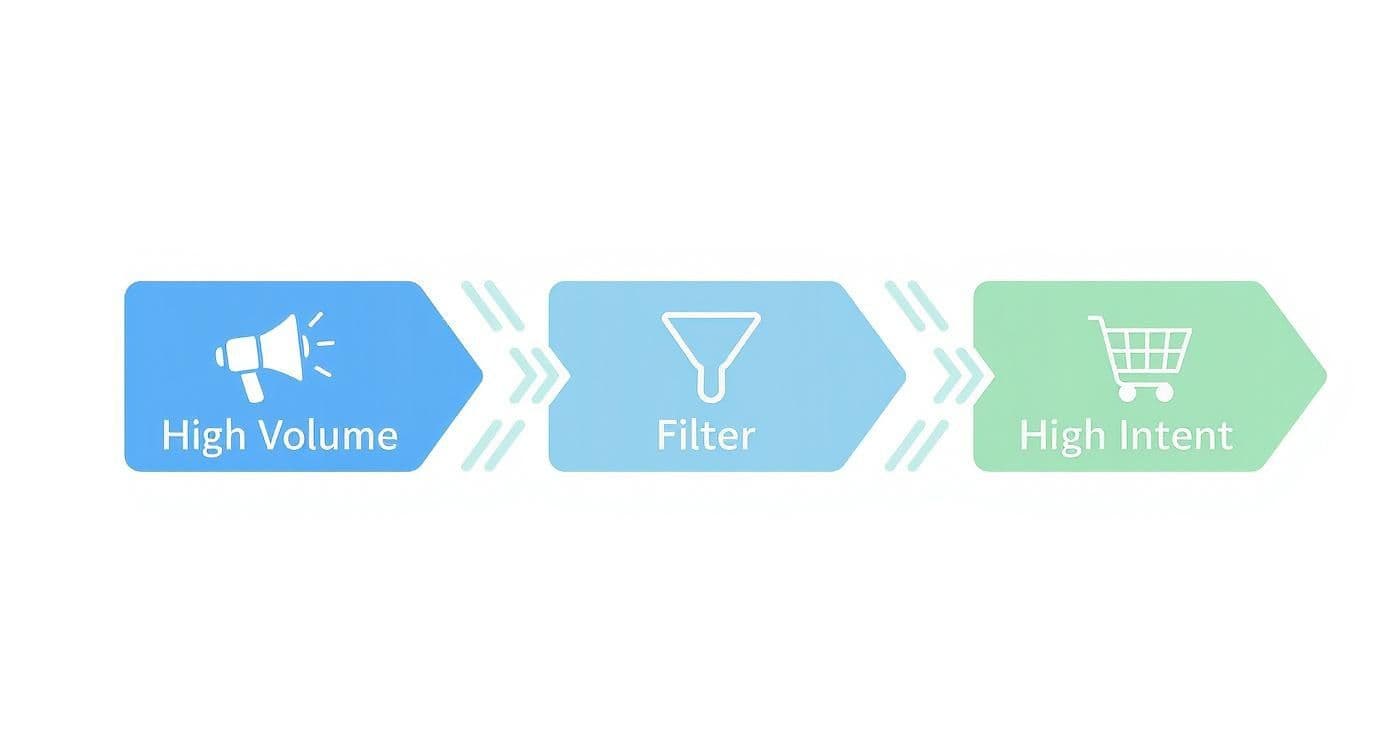A practical guide to long tail keyword research that drives traffic and conversions. Learn to find low-competition keywords that deliver real business results.
November 18, 2025 (2d ago)
Long Tail Keyword Research for Measurable SEO Wins
A practical guide to long tail keyword research that drives traffic and conversions. Learn to find low-competition keywords that deliver real business results.
← Back to blog
Long-Tail Keyword Research for Measurable SEO Wins
A practical guide to long-tail keyword research that drives traffic and conversions. Learn to find low-competition keywords that deliver real business results.
Introduction
Long-tail keyword research is about finding longer, ultra-specific search queries people type into search engines—phrases that are typically three or more words. They get less traffic individually, but they convert much better because they tell you exactly what someone wants. This guide shows practical methods to discover and prioritize low-competition, high-intent long-tail keywords so you can drive measurable SEO wins.
Why Long-Tail Keywords Are Your SEO Superpower
Trying to rank for huge, single-word terms like “marketing” is usually a losing battle unless you have huge resources. You’re up against well-established sites with massive authority. A smarter path is to target specific, conversational phrases that attract visitors who are closer to taking action.
People search in natural language now. Instead of typing “shoes,” many searchers ask detailed queries like “best waterproof trail running shoes for women.” That shift in behavior is the opportunity: long-tail keywords match real user needs and intent.
Short Head vs Long Tail Keywords at a Glance
| Attribute | Short Head Keywords (e.g., “shoes”) | Long Tail Keywords (e.g., “waterproof trail running shoes for women”) |
|---|---|---|
| Length | Typically 1–2 words | Usually 3+ words |
| Search Volume | Very high | Low to very low |
| Competition | Extremely high | Low to medium |
| User Intent | Broad, often informational | Highly specific, often transactional |
| Conversion Rate | Low | High |
With long-tail keywords, you trade raw volume for a smaller, highly qualified audience that’s much closer to converting.
The Power of High Intent
Long-tail keywords often capture clear user intent. Someone searching for “shoes” may be browsing, but someone searching for “buy size 10 red leather boots with side zipper” is likely ready to purchase. Targeting these specific phrases means meeting users at the right moment, which leads to higher conversion rates.
Long-tail queries make up a large portion of search demand, and many keyword studies show most queries have very low individual volumes—so the real opportunity is in aggregating many specific queries into targeted content strategies.12
“The real beauty of a long-tail strategy is that you stop chasing vanity metrics and start focusing on attracting the right traffic—the people most likely to become loyal customers.”
Gaining a Competitive Edge
Long-tail phrases face less competition, giving small businesses and newer sites a legitimate chance to rank on page one. Instead of trying to beat the big players at their broad keywords, carve out a profitable niche by answering very specific questions.
The goal is to get seen by more of the right people. Listening to your audience and answering their questions with targeted content is often more effective than broad, generic posts.
Finding Your First Batch of Long-Tail Keywords
Start with the data you already have. Your customer support tickets, sales emails, and live chat transcripts are goldmines of real phrasing and real problems. Look for recurring questions and exact wording—those become your seed long-tail keywords.
Start With What You Know
Before opening a keyword tool, mine your internal resources:
- Customer feedback: What features or problems do they ask about repeatedly?
- Support tickets: Phrases like “how do I…” show clear information needs.
- Sales inquiries: Questions right before purchase often indicate high intent.
These insights reveal the language your customers use and the moments in their journey when they’re likely to convert.

Leverage Free and Familiar Tools
After you’ve built a seed list, expand it using free methods. Google's autocomplete suggestions and the “People Also Ask” box are excellent sources for real-time, popular queries. Typing a broad term into Google and noting autocomplete suggestions reveals conversational long-tail queries people are searching for right now.
People Also Ask questions are perfect for building targeted posts that answer specific user needs—answering those questions can help you rank for clusters of related phrases.3
Imagine creating a tool or calculator that answers a common, high-intent question on your site. That kind of interactive asset both helps users and captures qualified leads; for finance-related examples, consider adding tools like the Mortgage Calculator or the Business Valuation Estimator to turn traffic into conversions.
Competitive research also pays off. Seeing what ranks for your target queries reveals content gaps and angles you can exploit.
Using the Right Tools to Uncover Hidden Gems
Digging through forums and autocomplete manually works for small-scale research, but it doesn’t scale. Specialized tools generate hundreds of long-tail, question-based phrase ideas from a single seed keyword and reveal patterns you’d miss by hand.
Automating question-based research is especially powerful. For YouTube-focused research, consider the YouTube Channel Value Estimator to understand what kinds of video topics attract attention and monetize.
Figure Out Which Keywords Are Worth Your Time
After you’ve collected potential keywords, prioritize them. Key metrics to focus on:
- Search Volume: Even low-volume queries can be valuable if intent is strong.
- Keyword Difficulty (KD): Lower difficulty means a better chance to rank without a huge backlink profile.
- User Intent: Categorize queries as informational, commercial, or transactional.
A keyword with low search volume but clear commercial intent can outperform a high-volume informational query when it comes to conversions.
Look Beyond Google
People search on many platforms. YouTube, for example, is a major search engine where users often use conversational queries. Targeting platform-specific long-tail phrases can uncover angles you’d miss by focusing only on web search. Use platform tools and analytics to find those opportunities.
Analyzing and Prioritizing Your Keyword List

A spreadsheet of keywords is only raw material. Turn that list into an actionable content roadmap by prioritizing phrases that balance traffic potential, realistic ranking difficulty, and clear business value.
The Three Pillars of Keyword Analysis
Focus on three core metrics:
- Search Volume — how often the term is searched monthly.
- Keyword Difficulty — a 0–100 estimate of how hard it is to rank.
- User Intent — what the searcher is trying to achieve.
Don’t chase volume alone. A low-volume, high-intent keyword can be far more valuable than a high-volume, low-intent term.
Decoding User Intent
Mapping intent is essential. “How to fix a leaky faucet” is informational; “emergency plumber near me” is transactional. Align content type with intent to get the right visitors.
This is where long-tail keywords shine: their specificity often reveals intent clearly, which makes content easier to match to searcher needs.
Creating a Simple Prioritization Score
Use a simple 1–5 scoring system for each keyword on Relevance, Difficulty (higher score for lower difficulty), and Intent (transactional gets the highest). Sum the scores and focus on the highest totals. This keeps your plan simple and actionable.
Writing Content That Ranks and Converts
Now that you’ve prioritized keywords, create content that genuinely helps users and signals value to search engines. Avoid keyword stuffing; instead, make your page the best answer to the searcher’s question.
Think of your main long-tail keyword as the central question your article must answer. Cover that question thoroughly and include likely follow-ups so readers don’t need to leave for more information.
Where to Place Keywords for Maximum Impact
Place your primary long-tail keyword in a few strategic locations:
- Page Title & H1: Primary keyword should fit naturally here.
- Introduction: Include the keyword in the first paragraph when it reads naturally.
- Subheadings (H2/H3): Use variations where appropriate.
- Image alt text: Describe images and include related phrases.
A well-placed primary keyword in these spots gives search engines a clear signal about your page’s focus.

It’s Not Just About One Keyword
Modern search understands context and related concepts. Cover related terms and subtopics naturally—this builds topical authority. For example, an article on “how to make cold brew coffee at home” should also cover “coffee to water ratio,” “coarse ground beans,” “steeping time,” and “best coffee for cold brew.”
When you cover a topic comprehensively, you often rank for dozens of related long-tail variations you didn’t target directly.
The Future of Search and Long-Tail Keywords
Search is becoming more conversational. Voice assistants and AI make natural-language queries more common, and that favors long-tail, question-style phrases. Optimizing for those detailed queries helps future-proof your content strategy.4
Voice Search and Conversational Queries
Voice searches tend to be longer and more conversational. People ask full questions like, “Where can I find the best deep-dish pizza in Chicago?” Optimizing content to answer full questions positions your site for voice and AI-driven search.
Preparing for an AI-Driven Search Landscape
Search engines will favor content that delivers clear, comprehensive answers to specific questions. Programmatic approaches can scale this work by generating focused content for many specific queries, but quality and user value must remain the priority.
“The more specific questions you answer, the more opportunities you create to be seen as the definitive resource in your niche.”
Ready to build a future-proof SEO strategy? Consider adding interactive tools that turn visitors into leads, such as the Business Valuation Estimator or the Mortgage Calculator.
Quick Q&A: Common Questions About Long-Tail Keyword Research
Q: Why should I target low-volume keywords?
A: Low-volume long-tail keywords often have clearer intent and higher conversion potential. Aggregated, they can deliver consistent, qualified traffic that converts.
Q: How do I find long-tail keywords without expensive tools?
A: Start with customer conversations, support tickets, and sales inquiries. Use Google Autocomplete and People Also Ask for additional ideas, and expand manually or with affordable tools.
Q: How do I prioritize which long-tail keywords to target?
A: Score keywords by Relevance, Difficulty (favor lower difficulty), and Intent. Focus first on high-relevance, low-difficulty, high-intent phrases.
Ready to Build Your Own Tools for Free?
Join hundreds of businesses already using custom estimation tools to increase profits and win more clients